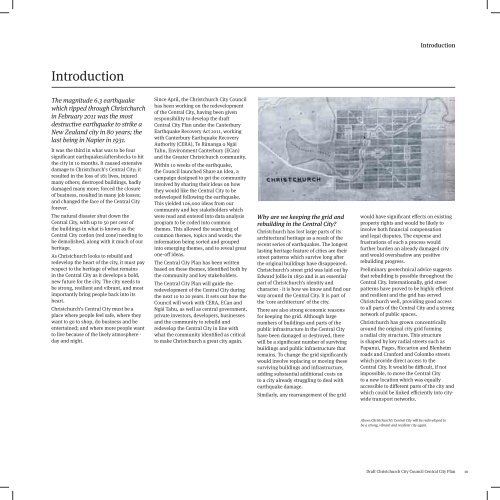Draft plan - Stuff
Draft plan - Stuff
Draft plan - Stuff
You also want an ePaper? Increase the reach of your titles
YUMPU automatically turns print PDFs into web optimized ePapers that Google loves.
Introduction<br />
Introduction<br />
The magnitude 6.3 earthquake<br />
which ripped through Christchurch<br />
in February 2011 was the most<br />
destructive earthquake to strike a<br />
New Zealand city in 80 years; the<br />
last being in Napier in 1931.<br />
It was the third in what was to be four<br />
significant earthquakes/aftershocks to hit<br />
the city in 10 months. It caused extensive<br />
damage to Christchurch’s Central City; it<br />
resulted in the loss of 181 lives, injured<br />
many others; destroyed buildings, badly<br />
damaged many more; forced the closure<br />
of business, resulted in many job losses;<br />
and changed the face of the Central City<br />
forever.<br />
The natural disaster shut down the<br />
Central City, with up to 50 per cent of<br />
the buildings in what is known as the<br />
Central City cordon (red zone) needing to<br />
be demolished, along with it much of our<br />
heritage.<br />
As Christchurch looks to rebuild and<br />
redevelop the heart of the city, it must pay<br />
respect to the heritage of what remains<br />
in the Central City as it develops a bold,<br />
new future for the city. The city needs to<br />
be strong, resilient and vibrant, and most<br />
importantly bring people back into its<br />
heart.<br />
Christchurch’s Central City must be a<br />
place where people feel safe, where they<br />
want to go to shop, do business and be<br />
entertained; and where more people want<br />
to live because of the lively atmosphere -<br />
day and night.<br />
Since April, the Christchurch City Council<br />
has been working on the redevelopment<br />
of the Central City, having been given<br />
responsibility to develop the draft<br />
Central City Plan under the Canterbury<br />
Earthquake Recovery Act 2011, working<br />
with Canterbury Earthquake Recovery<br />
Authority (CERA), Te Rūnanga o Ngāi<br />
Tahu, Environment Canterbury (ECan)<br />
and the Greater Christchurch community.<br />
Within 10 weeks of the earthquake,<br />
the Council launched Share an Idea, a<br />
campaign designed to get the community<br />
involved by sharing their ideas on how<br />
they would like the Central City to be<br />
redeveloped following the earthquake.<br />
This yielded 106,000 ideas from our<br />
community and key stakeholders which<br />
were read and entered into data analysis<br />
program to be coded into common<br />
themes. This allowed the searching of<br />
common themes, topics and words; the<br />
information being sorted and grouped<br />
into emerging themes, and to reveal great<br />
one-off ideas.<br />
The Central City Plan has been written<br />
based on these themes, identified both by<br />
the community and key stakeholders.<br />
The Central City Plan will guide the<br />
redevelopment of the Central City during<br />
the next 10 to 20 years. It sets out how the<br />
Council will work with CERA, ECan and<br />
Ngāi Tahu, as well as central government,<br />
private investors, developers, businesses<br />
and the community to rebuild and<br />
redevelop the Central City in line with<br />
what the community identified as critical<br />
to make Christchurch a great city again.<br />
Why are we keeping the grid and<br />
rebuilding in the Central City?<br />
Christchurch has lost large parts of its<br />
architectural heritage as a result of the<br />
recent series of earthquakes. The longest<br />
lasting heritage feature of cities are their<br />
street patterns which survive long after<br />
the original buildings have disappeared.<br />
Christchurch’s street grid was laid out by<br />
Edward Jollie in 1850 and is an essential<br />
part of Christchurch’s identity and<br />
character - it is how we know and find our<br />
way around the Central City. It is part of<br />
the ‘core architecture’ of the city.<br />
There are also strong economic reasons<br />
for keeping the grid. Although large<br />
numbers of buildings and parts of the<br />
public infrastructure in the Central City<br />
have been damaged or destroyed, there<br />
will be a significant number of surviving<br />
buildings and public infrastructure that<br />
remains. To change the grid significantly<br />
would involve replacing or moving these<br />
surviving buildings and infrastructure,<br />
adding substantial additional costs on<br />
to a city already struggling to deal with<br />
earthquake damage.<br />
Similarly, any rearrangement of the grid<br />
would have significant effects on existing<br />
property rights and would be likely to<br />
involve both financial compensation<br />
and legal disputes. The expense and<br />
frustrations of such a process would<br />
further burden an already damaged city<br />
and would overshadow any positive<br />
rebuilding progress.<br />
Preliminary geotechnical advice suggests<br />
that rebuilding is possible throughout the<br />
Central City. Internationally, grid street<br />
patterns have proved to be highly efficient<br />
and resilient and the grid has served<br />
Christchurch well, providing good access<br />
to all parts of the Central City and a strong<br />
network of public spaces.<br />
Christchurch has grown concentrically<br />
around the original city grid forming<br />
a radial city structure. This structure<br />
is shaped by key radial streets such as<br />
Papanui, Pages, Riccarton and Blenheim<br />
roads and Cranford and Colombo streets<br />
which provide direct access to the<br />
Central City. It would be difficult, if not<br />
impossible, to move the Central City<br />
to a new location which was equally<br />
accessible to different parts of the city and<br />
which could be linked efficiently into citywide<br />
transport networks.<br />
Above:Christchurch’s Central City will be redeveloped to<br />
be a strong, vibrant and resilient city again.<br />
<strong>Draft</strong> Christchurch City Council Central City Plan<br />
10
















